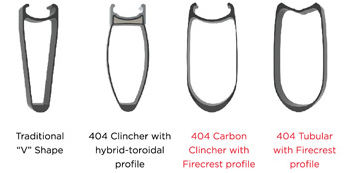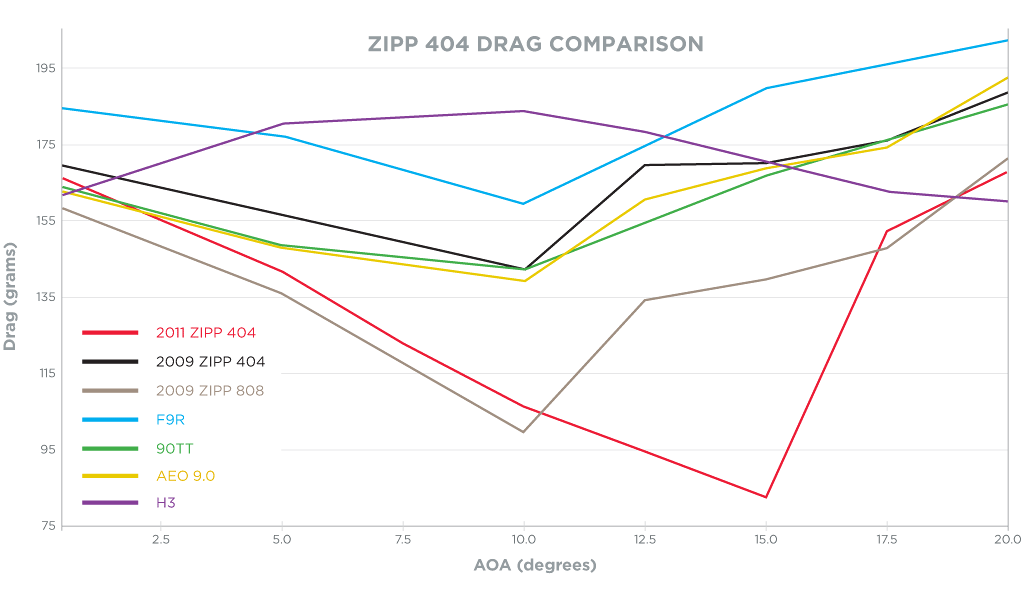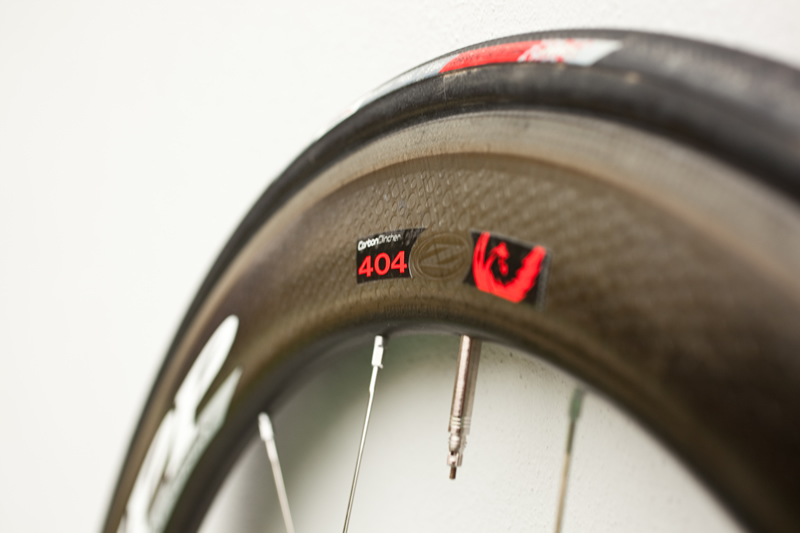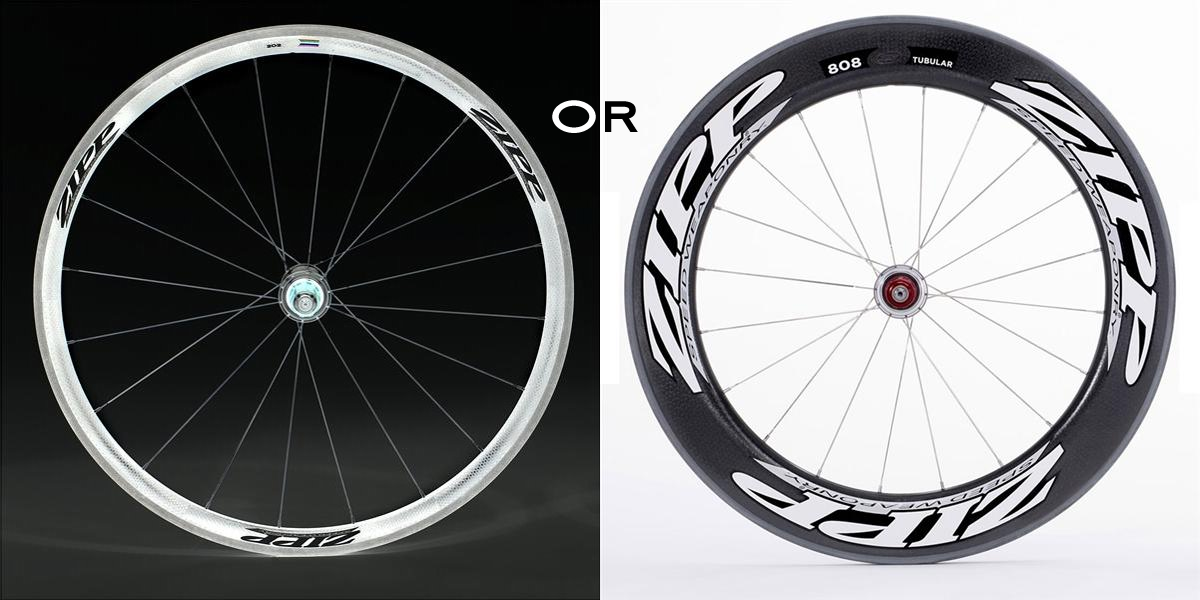Zipp Firecrest 404s are the new 808s

At the end of the 3rd stage of the 2007 Tour de France, Fabian Cancellara famously attacked the field from 1km out and managed to hold off a charging swarm of sprinters to win the stage. On that day he was riding a Cervelo Soloist shod with Zipp model 808 wheels. Afterwards, he excitedly told Zipp's Chief Engineer Josh Poertner "808 is the new 404 for me!" Jens Voigt had been riding Zipp's 808 wheels in flat stages and seeing this, Cancellara had decided to try them as well. As he related to Poertner later, "I just felt like when I went, I knew I was riding a TT bike compared to what these other guys were on." Obviously, the potential of aerodynamics (especially of the wheels) to have a decisive effect in a bike race was not lost on Mr. Cancellara.
Let's fast forward to 2010-2011. In May of 2010, Zipp announced a reworking of their 404 wheels with a completely new shape for that wheel's depth of 58mm. These wheels appear to turn Spartacus' 2007 quote on it's head. In many ways these new wheels equal or outperform the 808s that Fabian rode to victory in 2007. Now then, I'm no Fabian Cancellara (I'd be lucky if I'm equivalent to just ONE of his legs), however, after recently riding a set of the new Zipp Firecrest 404 carbon clincher wheels and digging through the data produced by Zipp and comparing it to my own observations, I'm beginning to think that a new quote is appropriate: "Firecrest 404 is the new 808!"

Firecrest Shape Development
During the development of the Firecrest 404 wheels, Zipp engineers decided to take a slightly different approach than has typically been used in thinking about and designing the rim shape. In the past, they general approach has been to think about the tire as the leading edge of an aerodynamic foil and then designing the rim shape with that as the foremost assumption. Doing so works fairly well, but the trade-off in that decision is that this shape may not work particularly well in the rear part of the wheel, where the shape is "reversed" to the air flow. In other words, the approach was to design for the front half of the wheel to be as good as possible, and then the rear "is what it is". In some cases, the rim designers don't even go to that extent, and this is evidenced by the "V" shaped rims still being produced. Those shapes aren't even particularly good for the front half of the wheel.
With their previous generation of rim shapes (what they called "hybrid toroidal"), the Zipp engineers had done a fairly good job of coming up with a shape that works really well on the front half of the wheel across a wide range of yaws, and is also relatively insensitive to tire width. Even so, this shape, when "reversed" on the trailing half of the wheel, didn't perform anywhere near as well as it did on the leading half of the wheel. So, the new thought process used in designing the Firecrest wheels was to see if tweaks could be made to the rim shape to get the rear half of the wheel to perform closer to the front half of the wheel, without adversely affecting the front half performance. This sounds like a great engineering challenge. Accomplishing this task would eek just a bit more performance out of the wheels, especially in a cross-wind situation.
Well…they did it…and it took taking the typical wheel design approach described above and basically "turning it on it's head". If you take a look at the new Firecrest shape that the Zipp engineers came up with and concentrate on a cross-section through the trailing half of the wheel, you can see that it looks as though the shape was designed with the thought of the tire being the trailing edge of the "wing section"…in almost a "Kamm" style of foil design. The Kamm concept is, simply put, the concept that a truncated airfoil section can have nearly the same drag as the entire foil would have, as long as the truncation is placed in the right spot. Kamm foils have received a lot of attention lately due to their use in the Trek Speed Concept frame tubing, but Zipp actually started using the concept on their wheels around three years ago in the pinch nuts of the 88/188 hubs. Using the Kamm shape on those pinch nuts actually allowed them to have that portion of a 17mm diameter axle have the same drag as the equivalent portion of 12mm round axle section, so obviously the advantages are understood.
According to Josh Poertner, the new shape dramatically improves the drag of the rear half of the 404 wheels, and they were actually able to make tweaks so that the front half of the wheel performance is as good as the old shapes. That's quite an impressive accomplishment.
One side benefit (pun intended) of improving the drag performance of the rear half of the wheels is that the location of the center of effort of the side force acting on the wheels is moved slightly rearward, which aligns it better with the steering axis of the bike. Side force in deep section wheels can be both a blessing and a curse…a blessing because it's the deep sections of the rims creating "lift" through air flow that results in that side force, but it also can be a curse if the effective center of that side force (i.e. if you replaced the overall side force with a single force at a point) is significantly offset from the bike steering axis. This then creates a torque about the steering axis depending on wind strength and direction and is what can make a wheel a handful in windy, gusty situations. However, moving the center of effort closer to the steering axis reduces these torques, and thus reduces the wheel's "twitchy-ness" in sidewinds.
This is actually what the Zipp engineering team was able to accomplish; lower drag AND lower side force induced torque abut the steering axis.

So, what's the bottom line? How well did the engineers do? Take a look at the drag plot released by Zipp, and in particular how the new Firecrest 404 shape compares to the previous 404 and 808 Zipp wheels.
From 0 to 10 degrees of yaw, the old 808 and the Firecrest 404 are nearly tied, with the 808 "beating" it by less than 10 grams of drag, or the equivalent of approximately 1 watt of power at race speeds (or, probably within the margin of error of the measurements.) Above 10 degrees of yaw however, the new 58mm deep Firecrest 404 shape is significantly faster than the older non-Firecrest 808 (the wheel Cancellara rode to victory as described above). Another "nifty" accomplishment by the Zipp engineering team was the fact that the drag performance for both the clincher and tubular versions of the wheel are identical. This hasn't always been the case for particular wheel designs.
Carbon Clincher
Since they were introduced at the same time as the Firecrest shapes, it's commonly assumed that Zipp's new carbon clincher technology is an integral part of the Firecrest concept. In short, it's not…the Carbon Clincher ("CC") technology is separate from the Firecrest shape development. In fact the first Zipp Carbon Clincher 404s I had a chance to ride were prototypes that didn't even have the final Firecrest rim shape. Of course, the CC technology spurred the Firecrest shape development and also helped accomplish the equivalent tubular/clincher aero performance mentioned above since the brake tracks of the CC wheels aren't required to be parallel, but that's more of a bonus than anything else.
So, Zipp came out with a carbon clincher. Some might say "What took so long?" According to Zipp, there were engineering tradeoffs they weren't willing to make until they were able to develop the technology to address those tradeoffs. One of those tradeoffs with typical carbon clinchers is a rider weight limit which is mainly driven by braking temperatures. With typical carbon wheel resins, rim temperatures can quickly get above the glass transition temperature of the resin (i.e. it starts getting "soft"), especially with larger riders and heavy braking conditions (i.e. mountain descents). Having the bead section of a carbon clincher rim get "soft" is a dangerous proposition…the beads can be deformed outward due to the air pressure being contained by the rim sidewalls, which can easily lead to a tire being blown off of the rim itself…definitely NOT something you want to experience on a mountain descent.
To address this problem, Zipp worked with their resin suppliers to develop a resin system for the braking area of the rim which has a MUCH higher glass transition temperature than typical carbon wheel resins, but still has good "toughness" (typically these are competing properties). What all of this means, is that the CC rims DO NOT have a rider weight limit, unlike many other carbon clincher wheels.
Another area the Zipp engineers wanted to address with their carbon clincher development was the durability of the bead areas. A fragile rim bead can easily be damaged just from typical rim impacts, especially once a tire has been punctured and before a rider has a chance to slow to a stop. If the rim beads are damaged just from a typical flat tire situation, that's obviously not acceptable for a top-shelf race wheel. The resin toughness mentioned above helps in this regard, and my own experience with a couple of flat tires on the CC rims tells me that they accomplished their goal.

Subjective Riding Impressions
Now that we've gone through the technical details of these wheels, I'm sure some of you are anxious to know how they "feel". In short…fast. You may be curious as to what my frame of reference is for that statement, and what I'm comparing them to is my tried and true race wheel setup (not only for TTs, but for road races and crits as well) of a set of non-C2 (i.e. narrow) Hed Jet 90s paired with low Crr tires and latex tubes. To be honest, when I initially rode the 404 CC prototypes, my first impression of them was that they didn't "feel" all that fast. However, I then realized that they had been supplied to me with what I'd consider a rather "pedestrian" set of tires and tubes (Continental GP4000S with butyl tubes). After swapping out the rubber for some high thread count (and low Crr) tires (a Bontrager RaceXLite Pro 23C on the front, and a Vittoria Open Corsa CX 23C on the rear), along with latex tubes, my impression of the wheels is that they nearly literally "came alive". With a good set of rubber on these wheels, they felt every bit as fast at steady-state as the much deeper Jet 90s, while also feeling just as easy to accelerate, especially when starting from an already high speed. Some might look at this wheelset's combined weight of 1557 grams and think that these wheels won't accelerate well…and they'd be wrong. Basically, what they are missing is that it's the aerodynamic properties of the wheels that makes a much bigger difference in acceleration than weight or rotational inertia differences. The rotational inertia of a wheelset is an extremely small portion of the total inertia that a rider needs to work against to accelerate, which I covered in, "Why Wheel Aerodynamics Can Outweigh Wheel Weight and Inertia."
How about the ride? Are the wheels "comfortable"? Are they laterally stiff? Once I shod the wheels with the "good" rubber I outlined above, they were just as comfortable as any other wheelset I've used those types of tires on…in short, the tires make a bigger difference in comfort than any wheel or rim properties. And remember, the wheelset I was comparing the 404 CC wheelset to is basically a low profile aluminum rim with a carbon cap, which is a much less stiff configuration in the vertical direction. As for lateral stiffness, I never experienced any rubbing of the brake shoes when either sprinting out of the saddle or climbing steep grades. Cornering on these wheels was sure and devoid of any surprises. In short, they were easily "stiff enough" for use in bike racing.
Now then, let's talk about the sensitivity to side winds and gusts…after all, this is a big point of emphasis in the technical details of this new design. Although I rarely find even deeper wheels much of a "handful" in windy conditions, it did seem to me that the Firecrest 404s were truly less sensitive to side winds. There was a definite sense of less "twitchy-ness" when encountering side gusts, and the wheels were easy to handle.
How about braking? This was my first experience with a carbon fiber braking surface and I was curious to see if I noticed any adverse differences as compared to the aluminum braking surfaces I have mostly ridden. Using the supplied Zipp cork compound pads (which were easy to replace in my brake holders) at first I found the rear pads to be a bit noisy under hard braking. After taking care to reset the "toe-in" on those pads, that noisiness went away and I found the braking on the CC wheels combined with the Zipp pads to be perfectly fine. At no point in the time that I used the wheels and pads did I feel that the braking lacked in any manner. They were never too "weak" nor grabby…overall, as Goldilocks would say, they were "just right".
Lastly, I'd like to talk about their durability, particularly in regards to impacts and riding on a flat tire. Unfortunately, (or…fortunately, I guess, in regards to this review) I actually suffered at 2 cases of impacts while riding (I blame my inconsiderate riding partners with not pointing out obstacles in a paceline!) that were hard enough to cause a "snakebite" failure of my tube (both cases with a butyl tube…hmmm…) and the Carbon Clincher sidewalls came through with flying colors and no damage at all. In these cases of flats, one of the things I was concerned about was any potential damage to the rim sidewalls after the flat occurred and while slowing down to a stop on a flat tire. In that case, the only thing protecting the thin sidewalls from the pavement is just the tire casing. But, as I said above, they didn't show any sign of damage and I was impressed with their apparent "toughness."
Drag Measurements
With the claimed low drag of these wheels, I decided to see if I could measure a difference between the Firecrest 404 CC wheel and my Jet 90 front wheel. To do so, I undertook a field test using Robert Chung's "Virtual Elevation" method. Since my baseline wheel (the Jet 90) was set up in TT-mode (i.e. shod with a Bontrager RaceXLite Aero TT 19C tire) I decided to also put an aerodynamically shaped tire on the 404 Firecrest as well; specifically, a new Bontrager R4 Aero 22C to match the wider brake track of the new 404. The Bontrager tire appeared to be a great match to the wider rim bed of the 404 CC as can be seen in the photo below. I didn't have a Zipp Tangente tire available to me at the time, but both the Zipp tire and the R4 Aero have a parabolically shaped tread to give better aerodynamics, but the Bonrtrager probably has a slight advantage in the Crr department (with an attendant slightly worse durability).
I took the wheels out to my preferred test course and did a few runs. The result? Even when looking at a yaw angle of near zero degrees to the wind (which is what my field testing uses) I measured an apparent decrease in "demand" for the 404 Firecrest with the R4 Aero tire of ~5W for a typical TT or Triathlon race speed. However, since the lower rolling resistance of the R4 Aero tire (as compared to the RaceXLite TT on the Jet 90) can account for up to 3-4W of that ~5W difference, I think the best that can be said from these measurements is that the Firecrest 404 is no slower at near zero yaw than a much deeper wheel like the Jet 90, when both are shod with tires of appropriate width for the rims. I also was able to test the older version 404 clincher with the same Bontrager R4 tire, and it too had ~5W higher "demand". Since both versions of the 404 I tested used the exact same tire, then it's safe to say that those differences were due to mostly the aerodynamic differences in the 2 versions.
Conclusions
The Zipp 404 Firecrest Carbon Clinchers are a VERY good wheelset. In fact, as I pointed out at the beginning of this review, they are actually faster than the old Zipp 808 design, which is a rim that is over 20mm deeper and has long been considered one of the fastest wheels one could use for bike racing. Are they a good value? In my opinion, yes. Although their list price of $2700 may seem a bit high, if you compare them to other carbon clincher wheels on the market that aren't anywhere near as aerodynamic, then the value starts to reveal itself. Don't forget, one of the BIG advantages of them being clinchers is the fact that one can easily tailor your tire choice to the event and conditions, and also get "world class" rolling resistance out of any of your setups just by installing latex tubes in the tires as well.
In short, one would be hard-pressed to find a better "do all" wheelset for bicycle racing of any kind…and despite being race wheels, their durability allows for frequent training use without having to worry about damaging them. Firecrest 404s are the new 808s!


